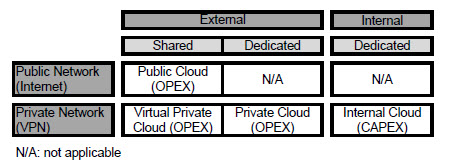The last few months have seen a cloud washing wave in the service provider market.
The phenomenon has used fascination with the word “cloud” and a curiously vague definition of the corresponding service models to repackage classic services under the cloud banner.
Even though the market has generally grasped the broad outlines of cloud models (market segmentation between IaaS, PaaS and SaaS offers), it has yet to master the different models that make up each of these segments.
despite the hype, the Cloud remains foggy
Take IaaS (Infrastructure as a Service) for example. In this segment we find terms like “Internal Cloud,” “Private Cloud,” “Virtual Private Cloud” and “Public Cloud.” Not too clear at first glance.
Making matters more complicated is the fact that there is no standard vocabulary for these services, even though the terms suggested by some major players in the market are gaining more and more currency, due to their pertinence.

This chart covers most of the models currently available on the market, while new models are likely to be developed in the near future by altering or combining these four basic models (such as Community Cloud or Hybrid Cloud).
The paradoxical gap between an abundance of communication and a vague imprecision in terms is exacerbated by the lack of any shared vision between IT and business divisions, some of which even subscribe to cloud services without coordinating with their IT divisions.
With all the confusion surrounding service models, selection criteria and conflicting initiatives, companies are increasingly coming to the following realization:
migrating to the Cloud requires a common policy
Since reducing costs is one of the main benefits to expect from the Cloud, massification and the scale effect naturally tend to promote the idea of unifying infrastructures. However, independent cloud subscriptions outside any unified IT strategy only serve to hinder any efforts at consolidation.
Furthermore, one of the conditions for an IT division turning to cloud services – as demonstrated by major technological revolutions in the past – is to ensure the convergence of the infrastructure powering the information system throughout the migration to the Cloud. This avoids creating an independent silo within the information system.
In order to succeed, this convergence needs a cloud policy that effectively promotes a common, unified approach within the company, particularly between the IT and business divisions, while also including other divisions involved in these decisions (financial, security/compliance divisions).
Now that we’ve grasped this concept, the question is: who's in the best position to define, promote and oversee this cloud policy?
IT divisions oversee this policy to ensure the success of the information system transformation
There are many reasons why IT divisions should handle this responsibility.
- First of all, since IT divisions guarantee the performance of the information system and enforce the security policy, they are in the best position to handle any cloud policy.
- In addition, IT divisions are further equipped to ensure this task due to their transformation to a new role as full-fledged internal service providers, whether these services are developed by their teams or not. By taking on this role, IT divisions improve their ability to promote and market their service offers for internal customers.
- Finally, by drafting a cloud policy, IT divisions ensure that consistent solutions are offered to their internal customers, while they also acquire the means to manage transformation plans that gradually implement their target systems.
the first step in this policy involves an information campaign on user features
This policy can be drafted using several steps and refined using feedback from IT and business divisions. In fact, this recommendation was offered in a recent study on the topic (“Write An Effective Cloud Use Policy”), which provides several best practices that IT divisions can use to reach this goal.
Among other goals, undertaking an internal information campaign is one of the most critical steps since there is still so much confusion in this developing market.
For this reason, compiling a clear presentation of these different offers can prove extremely useful for information campaigns concerning a clear cloud policy that aims to unify all efforts both inside and outside the IT division.
Bernard
This blog post was originally published in French here.
Photo credit:

My mission at Orange Business is to provide customers with high-value IT & cloud computing solutions that combine financial performance, business alignment and limited risk to ensure a successful transformation.